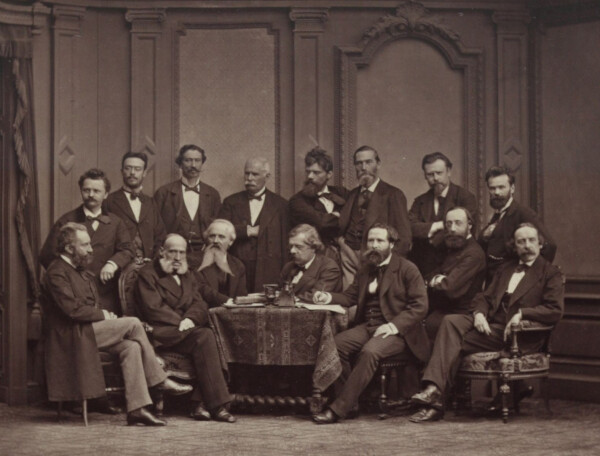Photographic Society

The Committee of the Photographic Society in Vienna photographed by Victor Angerer (detail), in: Photographische Correspondenz, 14. Jg., Nummer 164 (1877).
© ANNO | Austrian National Library
Founded in 1861, Vienna’s Photographic Society was dedicated to the research into, development of, and dissemination of photography, in addition to representing the interests of photographers. From 1864 on, the Society published the journal Photographische Correspondenz and in 1888 was involved in the foundation of the Imperial-Royal Teaching and Research Institute for Photography and Reproduction Techniques.
Around 1850, photography saw an upswing throughout Europe, and the trade came to be commercialized particularly in England and France, which was accompanied by the establishment of associations such as the Royal Photographic Society and the Société française de photographie. In Vienna, too, it was in the interest of the Chamber of Commerce that photographers should organize themselves based on the international example. Members of the loose community of the “Fürstenhofrunde,” the Lower Austrian Trade Association, and the Polytechnic Institute founded Vienna’s Photographic Society on 22 March 1861 with the purpose of “perfecting, expanding, and promoting photography in the best possible way.” Among its most prominent founding members were August Artaria, Peter Wilhelm Friedrich Voigtländer, Ludwig Angerer, Emil Hornig, and Joseph Petzval; they elected Anton Georg Martin as first chairman.
The association initially had around one hundred members, who came from both amateur and professional backgrounds: scientists, physicists, chemists, professional photographers, art dealers, opticians, pharmacists, artists, reproduction technicians, and publishers, some of whom were also members of other associations – for example the Club of Antiquarians, the Cooperative of Visual Artists in Vienna, the Association of Austrian Book Dealers, or the Alpine Club, where they in turn spread new ideas about photography. The Photographic Society was also affiliated with such state institutions as the Court and State Printing Press and the Military Geographic Institute, and it appointed such renowned experts as the Lumière brothers honorary members in order to promote international exchange. In addition to meetings, lectures, and exhibitions held on a regular basis, the association made an important contribution to the research into and development of photographic techniques, built up a special library, published the journal Photographische Correspondenz starting in 1864, attempted to clarify questions of copyright in photography, and honored special achievements with awards and prizes such as the Voigtländer Medal.
Although in the early years members came from all over the monarchy, in the 1880s photographic societies were also established in Prague and Budapest, and amateur associations that were more artistically and technically experimental gained in popularity, especially from the 1890s onward. The Photographic Society’s more general representation of photographers’ interests lost members to other associations; in some cases, people held dual memberships, yet professional photographers in particular tended to remain closed to new aesthetic approaches. The Society did not participate in the discourse on aesthetics and social and charitable issues that had come up in the early 1870s, but instead focused on “cultivating the scientific and technical side of photography.” In 1885 they furnished a laboratory with state-of-the-art photographic equipment, which was then handed over to Josef Maria Eder, a lecturer in photochemistry at the Vienna University of Technology and member of the Photographic Society.
As the scientific and technical upswing and rapid development of reproduction techniques called for more specialists, Eder came up with the idea of a public training institute: in 1888, the k. k. Lehr- und Versuchsanstalt für Photographie und Reproduktionsverfahren [Imperial-Royal Teaching and Research Institute for Photography and Reproduction Techniques] (now Höhere Graphische Bundes-Lehr- und Versuchsanstalt) opened as Europe’s first school specialized in photography, becoming an international model institute.
By the turn of the century, the Photographic Society’s membership may well have grown to over a hundred, but most of its members were from Vienna. The Society thus lost its international character and, due to the establishment of new, competing associations, its claim to sole representation. The Club of Amateur Photographers (from 1893 Camera Club) had existed since 1889, yet the Photographic Society would particularly be weakened by the Cooperative of Specialized Photographers, which was founded in 1905 and acted as an interest group of commercial photographers; it stood up for training regulations, a cartelized restriction of competition, and protection against amateurs and offered a health and support fund. It would be one of the most important photographic associations in Europe until World War I. The collapse of the Habsburg Empire, the global economic crisis and, ultimately, the era of National Socialism led to the decline of the Photographic Society.
Literature and sources
- N. N.: Statuten der Photographischen Gesellschaft in Wien, in: Zeitschrift für Fotografie und Stereoskopie. Organ der fotografischen Gesellschaft Wien, Band 5 (1862).
- Photographische Gesellschaft. www.photographische-gesellschaft.at (09/18/2020).
- O. Prelinger: Ein Rückblick auf 50 Jahre, in: Photographische Correspondenz, 48. Jg., Nummer 605 (1911).
- Michael Ponstingl: Die Explosion der Bilderwelt. Die Photographische Gesellschaft in Wien 1861–1945. Beiträge zur Geschichte der Fotografie in Österreich. Band 6, Vienna 2011.

